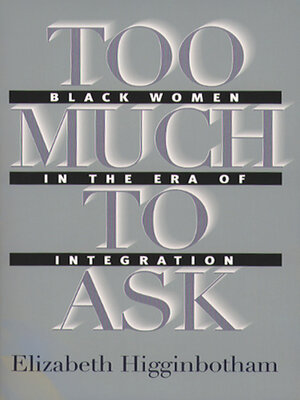Too Much to Ask
ebook ∣ Black Women in the Era of Integration · Gender and American Culture
By Elizabeth Higginbotham

Sign up to save your library
With an OverDrive account, you can save your favorite libraries for at-a-glance information about availability. Find out more about OverDrive accounts.
Find this title in Libby, the library reading app by OverDrive.



Search for a digital library with this title
Title found at these libraries:
| Library Name | Distance |
|---|---|
| Loading... |
In the 1960s, increasing numbers of African American students entered predominantly White colleges and universities in the northern and western United States. Too Much to Ask focuses on the women of this pioneering generation, examining their educational strategies and experiences and exploring how social class, family upbringing, and expectations — their own and others' — prepared them to achieve in an often hostile setting.
Drawing on extensive questionnaires and in-depth interviews with Black women graduates, sociologist Elizabeth Higginbotham sketches the patterns that connected and divided the women who integrated American higher education before the era of affirmative action. Although they shared educational goals, for example, family resources to help achieve those goals varied widely according to their social class. Across class lines, however, both the middle- and working-class women Higginbotham studied noted the importance of personal initiative and perseverance in helping them to combat the institutionalized racism of elite institutions and to succeed.
Highlighting the actions Black women took to secure their own futures as well as the challenges they faced in achieving their goals, Too Much to Ask provides a new perspective for understanding the complexity of racial interactions in the post–civil rights era.
Drawing on extensive questionnaires and in-depth interviews with Black women graduates, sociologist Elizabeth Higginbotham sketches the patterns that connected and divided the women who integrated American higher education before the era of affirmative action. Although they shared educational goals, for example, family resources to help achieve those goals varied widely according to their social class. Across class lines, however, both the middle- and working-class women Higginbotham studied noted the importance of personal initiative and perseverance in helping them to combat the institutionalized racism of elite institutions and to succeed.
Highlighting the actions Black women took to secure their own futures as well as the challenges they faced in achieving their goals, Too Much to Ask provides a new perspective for understanding the complexity of racial interactions in the post–civil rights era.







